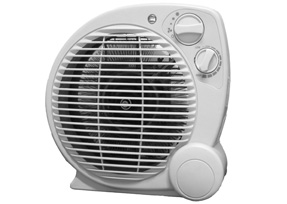Why use a fan heater:
Fan heaters consist of a large fan that passes air over a heated element. These heaters are ideal when rapid heating of a room and its surroundings is desirable. These small heaters are very easy to use and can be installed in places where installing other heating solutions may not be possible. The heaters are often used in small enclosures such as bathrooms and kitchens. These heaters can be installed in small kiosks, for example, to give a localized heat solution that might be otherwise too expensive to employ. Fan heaters are ideally used as a portable heating solution.
Fan heaters are convection heaters. They blow warm air across the room, ensuring that it circulates evenly. This means that warm air does not settle near the ceiling, as is the case with most other heaters. This ensures an overall warm environment.
Installing a fan heater:
Fan heaters can be mounted on walls and therefore save critical floor space. These heaters are often multi-directional, meaning that they have louvers that automatically swivel to distribute the flow of warm air around the room. When buying a fan heater, one should look out for a variable velocity fan heater. This will allow a person to control the speed of the fan and the air being circulated.
Some fan heater models are designed to be inset within a wall. This is a more subtle approach to the wall mounted fan heater design. Fan heaters also come in a tower-shaped model. These heaters can sometimes be used as air coolers during summer. Fan heaters that are meant to be used in bathrooms often come with a pull cord as the main switch to turn on the heater.
Things to look for when buying a heater:
When buying a fan heater, look for safety features such as tip over switches and overheat protection. Heaters that have 180-degree range of oscillation will easily distribute air around the room. Some advanced versions come with a thermostat and an automatic timer. These additional features ensure that the room is kept at a specified temperature at the right time. This allows you to conserve energy by preventing unwanted overheating.










